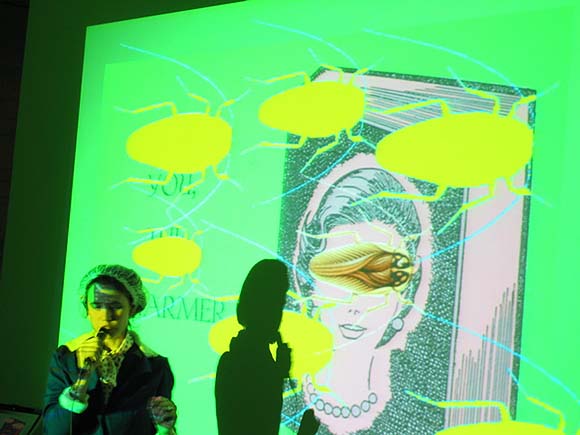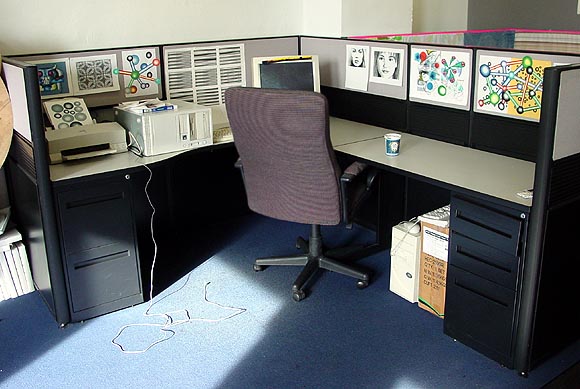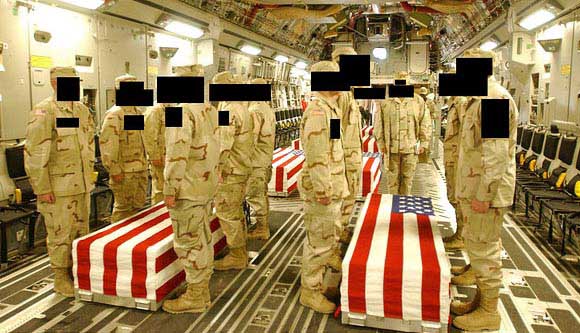View current page
...more recent posts
(Edited slightly). Thanks to everyone who came to the opening of ART)@*!(WORK. The group show takes place in an office cube farm on the 16th floor of a building at 520 8th Avenue (between 36th and 37th). I carried out my plan which was to sit in a cubicle drawing pictures on the computer and shooting the shit with people. Neither the cube ambience nor the business casual attire was particularly ironic in my case--it's pretty much how I dress and live, now, but especially in 1995-2000, the time period in my working life I was "channeling" in the performance by using an old computer, Windows 98, and MSPaintbrush as my main drawing tool. I did a rendering of Chloe Sevigny based on an artnet photo by Nancy Smith I downloaded earlier in the day (at home), got panicky that the drawing looked like garbage, saved it and started making spheres. About a half hour later I booted it back up and found it was a passable likeness! so I kept it on the screen. The picture still needs work but I have 42 more hours to sit in the space, so this shouldn't be a problem. Expect also some photos and commentary on some other artists' work in the coming weeks. (Another slight update: I'm the only artist in the show treating this like a residency and working in the space full time after the opening. A few others are popping in for a bit of a temp work.)

Around 8:00 pm Irene Moon did a live performance on the theme of social and antisocial insects (more specifically the scientific paper "Building Web-Based Interactive Keys to the Hymenopteran Families and Superfamilies" from Moon's work life as an entomology grad student) with electronic music, video, shoutouts to E.O. Wilson, and one major costume change from weird Bee-Woman zombie tourguide to southern-accented "Pleasant Planarian." "Fly Me to the Moon" was rendered in a well, drone, interlaced with factoids about insect eating and mating habits. At the end of the gig, everyone in the hive rubbed their forelimbs together and buzzed appreciatively. (Photo of Irene Moon from the Carbon Records website.)

Be there (tonight). "Oh, sorry, man, I didn't see your blog. You should have emailed me."
Good post on why a National ID card is a horrible, scary idea. The US Senate votes today: call your Senator (if it's not too late--Christ, who can keep up with all the bad legislation coming down the pike?).
The REAL ID Act requires driver's licenses to include a "common machine-readable technology." This will, of course, make identity theft easier. Assume that this information will be collected by bars and other businesses, and that it will be resold to companies like ChoicePoint and Acxiom. It actually doesn't matter how well the states and federal government protect the data on driver's licenses, as there will be parallel commercial databases with the same information.(hat tip to dratfink)
Even worse, the same specification for RFID chips embedded in passports includes details about embedding RFID chips in driver's licenses. I expect the federal government will require states to do this, with all of the associated security problems (e.g., surreptitious access).
REAL ID requires that driver's licenses contain actual addresses, and no post office boxes. There are no exceptions made for judges or police -- even undercover police officers. This seems like a major unnecessary security risk.
REAL ID also prohibits states from issuing driver's licenses to illegal aliens. This makes no sense, and will only result in these illegal aliens driving without licenses -- which isn't going to help anyone's security. (This is an interesting insecurity, and is a direct result of trying to take a document that is a specific permission to drive an automobile, and turning it into a general identification device.)
REAL ID is expensive. It's an unfunded mandate: the federal government is forcing the states to spend their own money to comply with the act. I've seen estimates that the cost to the states of complying with REAL ID will be $120 million. That's $120 million that can't be spent on actual security.
And the wackiest thing is that none of this is required. In October 2004, the Intelligence Reform and Terrorism Prevention Act of 2004 was signed into law. That law included stronger security measures for driver's licenses, the security measures recommended by the 9/11 Commission Report. That's already done. It's already law.
REAL ID goes way beyond that. It's a huge power-grab by the federal government over the states' systems for issuing driver's licenses.
REAL ID doesn't go into effect until three years after it becomes law, but I expect things to be much worse by then. One of my fears is that this new uniform driver's license will bring a new level of "show me your papers" checks by the government. Already you can't fly without an ID, even though no one has ever explained how that ID check makes airplane terrorism any harder. I have previously written about Secure Flight, another lousy security system that tries to match airline passengers against terrorist watch lists. I've already heard rumblings about requiring states to check identities against "government databases" before issuing driver's licenses. I'm sure Secure Flight will be used for cruise ships, trains, and possibly even subways. Combine REAL ID with Secure Flight and you have an unprecedented system for broad surveillance of the population.
Is there anyone who would feel safer under this kind of police state?
Film critic tedg on Ridley Scott's Kingdom of Heaven, starring Legolas (scroll down). Practically no "mainstream" critic talks about film in terms of image/editing/camera movement like this.
I've commented before about Scott's ability to have each camera shot mature at some point (about two seconds before it ends) in such a way that it anticipates the next image. No one else seems to have this ability. The famous George Stevens method was to shoot every scene from every angle and create a rhythmic dance of the eye afterward. Most filmmakers follow something like this today, which means that the registration of every shot happens after it appears, not before as with Scott.I'm getting more interested in Stevens (Shane, Penny Serenade, Giant, etc) these days and would like to follow up, through observation and the occasional comment, on this thesis of pre- and post-registration of visual information that tedg contrasts between his work and Ridley Scott's. Fascinating stuff!
Most of this, I think, is in how the camera moves. Early on, he establishes certain rules of vision that tell us when he does this, this something will follow, all done by how the camera moves. Because this visual logic is so rigidly followed, we cannot see the usual seams between real and computer generated images. He must have these rules written down for the hundreds who must be involved to understand and follow.
The story itself is mundane as with all such which have to have mass appeal. The acting is less aggressive than in his last two projects, and for my tastes that's good because it allows us more space for the cinematic experience.
Some images remain in my mind after a few days. when Saladin begins his attack on Jerusalem at night and the fireballs start coming at us over the horizon. This is truly impressive and serves as the template for the entire battle.
In that same timeframe, we have a shot of our hero anticipating. It is a three-part shot. First we see a smoky moon, then the camera moves down and to the right and we see a fluttering canvas. Each of these are amazingly rich, with the smoke anticipating the waves of the canvas. It is as if all the sea and the rolling hills and the desert were compressed into those two images. Then we move on down to our hero's face. In this ten seconds, Scott makes up for all [Orlando] Bloom's weaknesses. [...]
"Go East (Additive)" [mp3 removed]
"Go East (Subtractive)" [mp3 removed]
Both tunes are the same rhythm pattern, played with different "lead" instruments. I'm pretty amazed how much the pattern changes from tune to tune, and how much variety there is within each rendering. Except for some slight virtual knob turning, I mostly just set this up, got out of the way and let the machines do their thing. The subtractive version has some "skips" that I may or may not fix.

From UnFair Witness: "The Pentagon blacked out the faces and identifying information in some photos showing honor guards for coffins lining the interiors of C-17 transports [for returning Iraq War dead]. Thomas Blanton of the National Security Archive called the edited images 'an outrage and an insult.' (Photo Credit: Defense Department Photos Via Nsarchive.org)"
Mithras, on the above photo: "Nothing more evocative of this war for me than the officially-anonymous living honoring the anonymous dead. "
j asked if I was going to do sound-related work in connection with my upcoming performance piece of sitting in an office cubicle making art for
Yesterday one of the organizers politely but nervously asked me if I still have an, um, job these days. The answer is yes! Where I work now isn't so physically different from this "art project" and my past jobs; it is more demanding, though. We could talk about it, but let's just say blogging about my perma (as opposed to permatemp) gigs is not part of my long-term survival plan as an artist. (But

My cubicle for the ART*%@((WORK show described below. The moire pattern on the chair isn't me being deliberately psychedelic--it's a "digital camera error."
